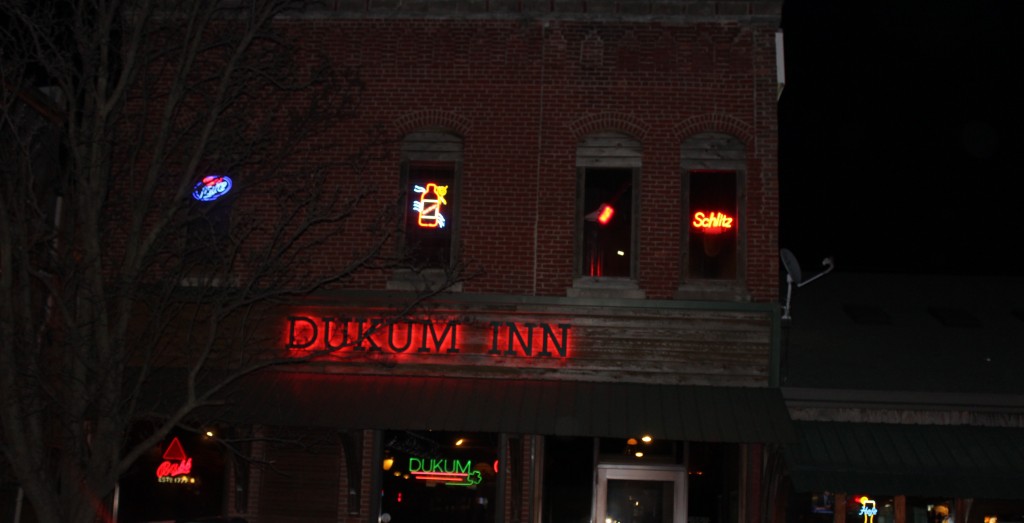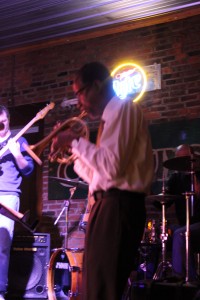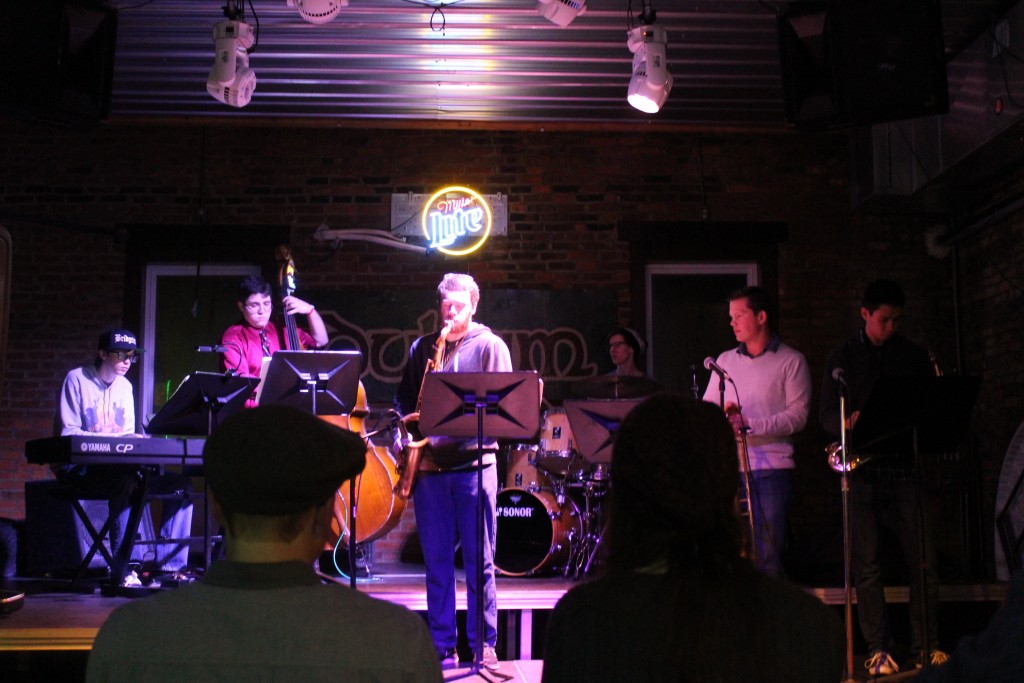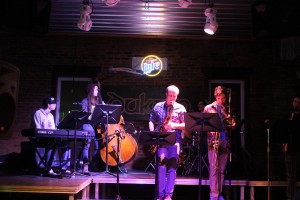On Friday night, the guest performer, visiting judges, and clinicians are invited to play a set for the larger Kirksville community, known as the “Judge’s Jam.” Since this is an additional, independently sponsored event held at the Dukum Inn (“Do come in”), a local bar and grille in downtown Kirksville, the atmosphere is much more relaxed than the Saturday evening performance on campus; in many, but not all, respects, the setting is akin to a jazz club or listening room, allowing for a more authentic and traditional jazz experience.
Read More
As Ryan Staines puts it,
[The Judge’s Jam is] one of the more understated parts of JazzFest, I think. It’s a fun atmosphere, it’s a great experience—you get to hear great live music—and there’s no pressure to like clap at the wrong time [for example]. You can go there and you know how to interact and socialize with people.… It’s a lot of fun.
There are, however, drawbacks to this environment, especially since the Dukum is not an actual jazz club. As Prof. Tim AuBuchon explains,
Once you get to a certain level, say like Sonny Rollins and Keith Jarrett, those guy don’t play clubs anymore, which I’ve heard there’s sort of a mixed set of emotions that goes with that because playing a club is really neat when it’s all working well and people are into it—it’s more rowdy, but that’s a lot of good energy. But I think the downside of playing at clubs is, invariably, you’ll be in the middle of a ballad and someone orders a daiquiri. We just had a jazz guest artist last week [saying], “Someone always has to order a daiquiri, and the blender starts up right in the middle,” y’know? It’s a very reverent… sort of thing. It’s more of a living interaction with the audience, so it’s really a lot of fun. [Those kinds of places] really wear on you though.
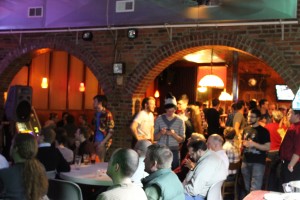
Judge’s Jam (JF48) crowd in the “Dukum Up.” The wall separating the bar area from the performance area partially separates the players from “the rowdies,” as AuBuchon puts it, at least visually. (Photo by author)
When I mentioned this point to Ryan, he agreed that the combos that play at the Judge’s Jam, or at similar events and venues, know what to expect from their audience going into it. They provide atmosphere music for some while others sit down to actively listen appreciate the performance.
Though the combos tend to be comprised of Truman students and faculty, the Judge’s Jam is independently sponsored to distance it from any official affiliation with Phi Mu Alpha or Truman State University. At any rate, it is responsibly organized such that underage attendees (generally music majors and other Truman students, ages 18-20) can attend after having their hands marked at the door. The vast majority of audience members are upperclassmen from the music department and visiting alumni in town to catch up with old friends and professors.
As an unofficial event, the guest artists and judges are not required to play at the Judge’s Jam, though AuBuchon notes,
Almost always [the guest artists] want to come and play. We’ll get some of the judges, who are rhythm section players and professional jazz guys from Kansas City or St. Louis or Columbia, and we’ll play a few… of the guest artist’s tunes [and]… some standards.
A student combo opens the night and after the judges play, there is an open jam session for any local musicians who want to play, typically comprised of jazz students and professors. Even as an unofficial event, it is a tradition that has played a major role in the larger community aspect of the festival.
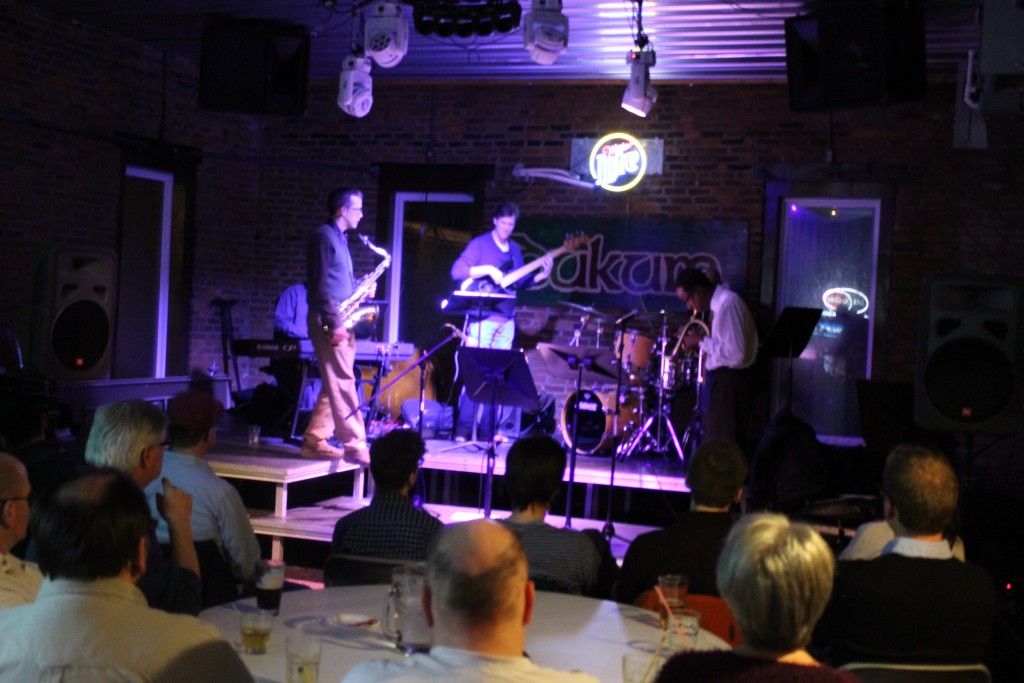
The Judge’s Jam “listening room” crowd and the judge’s combo (JF48). From left to right: Ken Kehner-piano, Tim AuBuchon-saxophone, Marty Morrison-bass, Ron Miles-cornet, and Kevin Hennessy-drums. (Photo by author)
The Judge’s Jam–Friday, February 26, 2016
The first clinic wrapped up around 6:00 p.m., leaving three hours of down time before the Judge’s Jam. I went home to eat dinner, then made my way to Dukum. I climbed the stairs to the “Dukum Up” and chatted with the PMA chapter president, Ryan Staines, who was working the door. After a minute, I paid the $5.00 cover charge, got a wristband indicating I’m over 21, and went in. It was just after 9:00 p.m. and the combo opening for the judges, Jazz at Dinner, was kicking off their first tune.
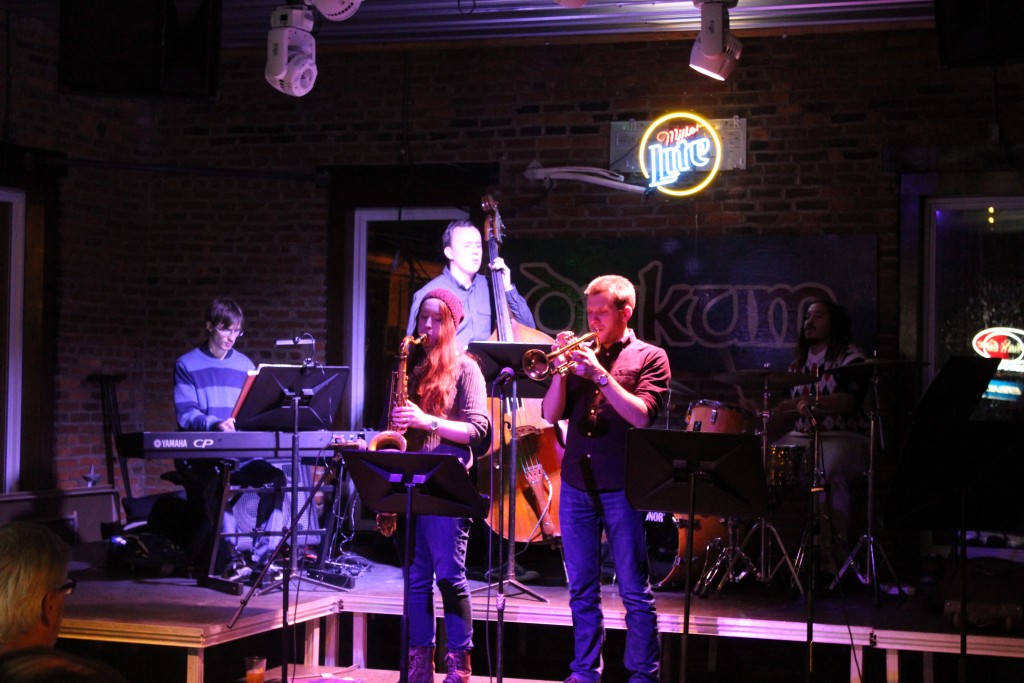
Student combo, Jazz at Dinner. From left to right: Michael Marmorstein-piano, Lindsey Davis-saxophone, Zach Green-bass, Jonathan Vieker-trumpet, and Marcus Ratter-drums. (Photo by author)
Already overwhelmed by the size of the crowd, I made a beeline over to the bar and ordered a drink. While I waited, I surveyed the room; I saw some people I knew and some people I knew I didn’t want to run into. I got my drink and elbowed through the crowd to an open space near the band. Along the way, I said quick hellos to some friends and tried, unsuccessfully, to catch up with an old professor who was preoccupied getting a refill on his whiskey. Finally, I settled in a corner, trying to ease my claustrophobia, and took everything in around me.
There were a couple dozen professors drinking and talking with their spouses and friends. I figured there were a few Kirksville natives and Dukum regulars peppered in the crowd, but I wasn’t totally sure. One thing I was sure of was that well over half of the crowd were TSU students and alumni. Most were gathered in the bar area, so they wouldn’t be as disruptive, but this was hard to avoid.
Many of the musicians I spoke with (PMA members, especially) told me that one of the best parts of JazzFest is that it gives alumni a reason to come and visit. There are plenty of jazz concerts throughout the semester, but knowing that other alumni and old friends will be in town is a major incentive for them to trek back to Kirksville.
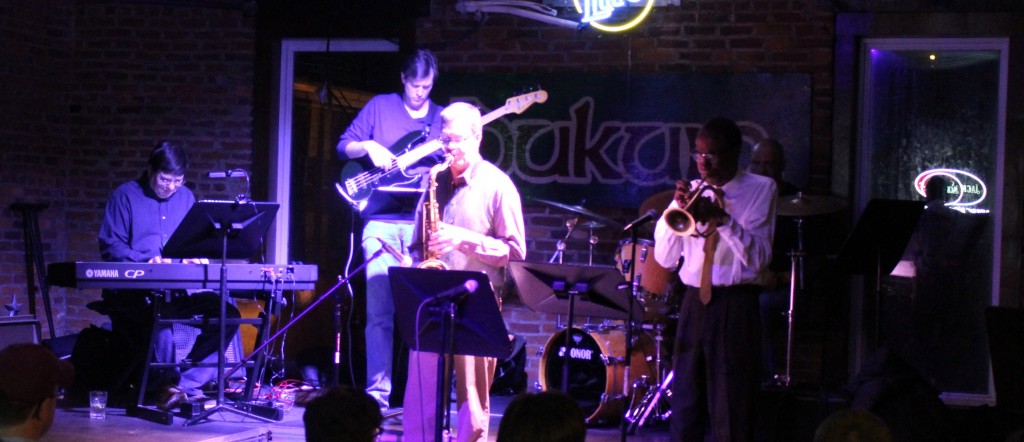
Judge’s Jam. From left to right: Ken Kehner-piano, Marty Morrison-bass, Tim AuBuchon-saxophone, Ron Miles-cornet, and Kevin Hennessy-drums. (Photo by author)
By 9:30, Jazz at Dinner had finished their set, which all too few people paid attention to. The judges (including Ron Miles) set up quickly, so as to minimize dead air, and dove head first into their set.
More and more people migrated out of the bar area and into the makeshift listening room. Many were already on their second or third drinks, and I was no exception. This was good, though–for better or worse, the more the audience loosened up, the more willing they were to voice their opinion of the music. Audience feedback plays an essential role in jazz; responsive audiences fuel the musicians and their performance. Of course, a good audience understands when to be quiet and when to rejoice. Chatter on the left side of the room had almost ceased completely as the audience focused their attention on the music. Meanwhile, the people on the right side (by the bar) kept getting louder. Luckily, no one dared ordering a daiquiri.
The judges played a range of tunes in every style–new interpretations of old classics. Though they had very little time to rehearse, like all great jazz musicians, they knew how to read each other; they were experts of the special blend of nonverbal communication known only to jazzers. Miles, especially, stunned his listening audience (ironically, most of the music students and alumni on the other side of the room were too caught up in conversation to care). It was clear from his playing that he was channelling every part of himself into his performance, but he never looked like he was enjoy himself all that much.
To be fair, last year’s guest artist, Ray Anderson, was atypically eccentric and playful. This is not to say that the guest artists are usually unfriendly and straight-laced, but Anderson brought an air of excitement and fun with him. As Ryan Staines recalls,
Ray Anderson played a few hours at the Judge’s Jam the night before and he had a lot of fun. They were marching around up stairs, he tried to go downstairs, and we were like, “No! No! Stay up here!” [Laughs] They were really having a good time. His interactions with the students—he was very open. Maybe not saying, “hello” to everyone, but if you come up to talk to him, he’ll gladly say “hello,” take a picture, and talk to you for a little while.
While Anderson managed to put on a more engaging performance, Miles’s performance was no less good, at least musically speaking. Though his low-key approach may not have been as outwardly fun as Anderson’s, Miles’s performance was remarkable. The audience seemed to agree.
As the night wore on, people began to loosen up. Hardly anyone called out praise for the exceptionally talented opening act; yet, only an hour later, people were more than willing to throw out a few respectful hoots and hollers, a fervent “Umph,” or an almost involuntary “Yeah” as if they were so moved, they couldn’t help it. As all jazz performers know, there is a fine line between respectful cheering and rowdiness.
I think the concert hall is an idealized environment, but it’s fun to have the rowdy people sometimes too. I have definitely played some gigs where there have been [rowdy people]. I don’t think I’d want it all the time, but it’s kind of fun to have someone in the back saying, “Yeaaah! [Rowdy cheering] Play a blues next time!” I mean, I used to live in Chicago and you’d have somebody in the back doing that once in a while. And if they’re really jazz fans, it’s fun. If they really just want B.B. King instead, that’s a drag. Generally, if [the audience] knew what they wanted, they knew what they were listening to, [so] if they felt like telling you what they wanted to hear, I mean, that’s great! And you can clap in the middle of solos in jazz, which in concert halls, people have to be reminded sometimes that you an actually clap during the solo. It’s a little less formal, even in that setting, than an orchestra concert where (mock warning) “you’re not supposed to clap between movements!”
–Prof. Tim AuBuchon
Overall, there was a charming intensity about the audience in the listening room. Many people stared down deep into their drinks, heads nodding in rhythm, bodies rocking, toes tapping. These were the real music fans.
One of these fans was the professor who had snubbed me earlier. I crossed over to him between tunes and tried again to hear his thoughts on the music; this time, he was much more excited to see me. We continued to catch up in little bursts throughout the night, even toasting to my impending graduation and to everything thereafter. There was a sense of celebration and fellowship in the air, and I noticed a lot of people having similar interactions with old professors and friends.
The judges concluded their set around 10:30, opening the stage to impromptu combos. The crowd had started to thin out, leaving behind the die-hard music lovers. Within fifteen minutes, a combo had assembled and started into their first tune. After a rocky start, they managed to figure out each other’s quirks and ended up sounding tighter and tighter with every tune.
Around 11:45, I started to get tired. By that time, at least four combos had formed and disbanded as different musicians tapped in and out. There were still about twenty-five people hanging around, but the only person I knew was my professor, nursing another whiskey and grooving harder than anyone.
Finally, I gathered my things and walked home, mentally preparing myself for the second day of JazzFest 48.

